www.chechurubiera.info - an online magazine for fans of Chechu Rubiera

 VUELTA A ESPAÑA
VUELTA A ESPAÑA
Introduction
CHECHU RUBIERA
Rubiera Retro : Fan Diary from Asturias : Ciclismo Fondo in Asturias with Chechu : Dad In Support
VUELTA RETRO
1936 : Julián Berrendero : Luis Ocaña : José Manuel Fuente : Pedro Delgado
SPAIN
Vigo : The Way of St James : Covadonga : Prince of Asturias Award : Mountain Facts : Exploring the Alhambra : The Pass of the Moor's Sigh
PEOPLE
Famous Galicians : Prince of Asturias : Catherine of Aragon : Federico García Lorca
CULTURE
Bull Run : Siesta : Interiors - Jaime Hayon, Nani Marquina : Saving El Burro : Spanish Nicknames
FOOD
5 To Try : Atlantic Spain : Fabada Asturiana : Growing Fabada Beans : About Olives
BOOKS
¡Guerra!
SPAIN
VIGO, HOST CITY OF STAGE 1
The 2007 Vuelta gets underway in Vigo in Galicia, home town of the hugely popular 2006 Tour de France winner in waiting, Oscar Pereiro.
Vigo is the largest fishing port in Europe. Nearly half of the fish and shellfish caught in Spain (half a million tonnes), is supplied by the Galician enormous fishing fleet.
It's also an industrial area, with automotive plants, shipyards, and auxiliary industry. Galicia's leading employer, PSA Peugeot Citroën, is based in Vigo.
Visitors are drawn to the Bario de Berbes, an old quarter of cobbled alleyways and excellent tapas bars.

Galicia is one of the least known corners of Western Europe.
Spaniards like Galicia's Atlantic beaches. It has a rugged coastline, cut with fiord-like rias (long associated with smuggling) and dotted with fishing villages. Galician seafood is said to be the best in Spain. Second only to the Portuguese, the Spanish eat more seafood than any other European country.
But without the pilgrimage route to Santiago de Compostela, few foreign holidaymakers would venture into Galicia, this "damp, poor, dolefully beautiful territory jutting out over Portugal." (John Hooper in The New Spaniards). And until recently, Galicia was a byword for poverty, hunger and emigration. A railway from Madrid didn't reach Galicia until 1883, and despite new motorways, it's a long seven hour drive from the capital.
More than four out of five Galicians speak galego, a cross between Spanish and Portuguese. The region boasts it's own literature and culture. But unlike Catalonia and the Basque Country, there is little popular support for independence from Spain. Galicians seem content politically to be Spaniards, although perhaps not culturally.
Galicians are proud of their supposedly Celtic origins, but thanks to modern genetics, it seems they're probably not real Celts. Nevertheless, Vigo's football club is called Celta de Vigo, Celtic symbols, legends and superstitions abound and the sound of bagpipes is common.
PEOPLE
FAMOUS GALICIANS

Oscar Pereiro was born in Galicia, Julio and Enrique Inglesias and Fidel Castro are all descended from Galicians.
There are many wonderful writers, artists, designers, politicians, musicians. Even conquistadors and a dictator. Their names may not be widely recognised, but they are definitely worth further investigation.
See WIKIPEDIA
SPAIN
THE WAY OF ST JAMES

See WIKIPEDIA (en)
Also WIKIPEDIA (esp)
SPAIN
COVADONGA, ASTURIAS
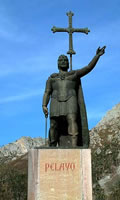 On stage 4, the peloton climbs towards a mountain top finish in the Lagos de Covandonga, the lakes of Covadonga.
On stage 4, the peloton climbs towards a mountain top finish in the Lagos de Covandonga, the lakes of Covadonga.
Covadonga (literally, deep cave) has great meaning for Asturians. It was the scene of the first significant victory by Christian forces in Spain following the Moors conquest in 711. The victory at Covadonga assured the survival of a Christian stronghold in northern Spain, and today is regarded as the beginning of the Reconquista.
Some years after the Muslim conquest, a Visigoth nobleman called Pelayo held the territory against a number of attempts to re-establish Muslim control. The Kingdom of Asturias became a Christian stronghold against further Muslim expansion.
According to legend, Pelayo received the breath of the Virgin who appeared before the Christian soldiers in an historic battle in 722. The cave in which the soldiers had taken refuge was converted into a place of Christian worship and King Alphonso I built the first chapel here.
A monastery, built at the foot of the cave which guarded la Santina, the Virgin of Covadonga and patron of Asturias, was destroyed by fire in 1777.
From the cave, a long tunnel has been bored through the rock which contains the tombs of Don Pelayo and his wife, and King Alphonso I. The tunnel leads to the Basilica of Covadonga built between 1877 and 1901. The surrounding mountains are part of the Picos de Europa, Spain’s largest national park.
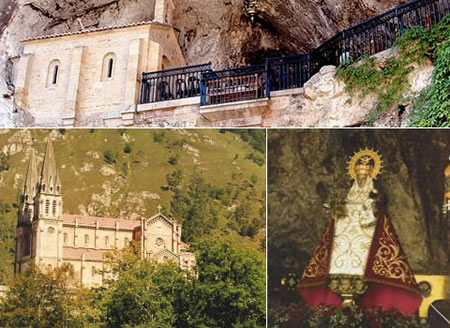
SPAIN
MOUNTAIN FACTS
Spain is the second highest country in Europe after Switzerland, with most of the land lying above 500m.
The five highest mountains are Teide (3718m, Tenerife), Mulhacen (3479m, Sierra Nevada), Aneto (3404m, Pyrenees), Veleta (3392m, Sierra Nevada) and Llardana (3375m, Pyrenees).
The highest climb in the first ten stages of the Vuelta is to Arcalís in Andorra, 2200m above sea level.
Until 1913 (when it melted), the most southerly glacier was the Corral de la Veleta in the Sierra Nevada.
SPAIN
EXPLORING THE ALHAMBRA
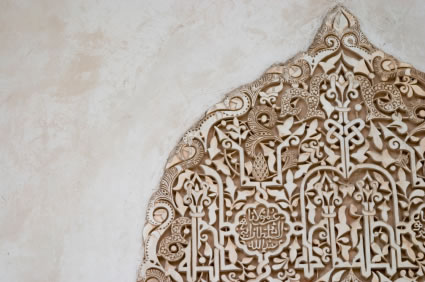
Towering out of an elm-wooded hillside above Granada is Spain's most revered monument.
The ochre-tinted enclave of the Alhambra is an exalted wonder of the temporal world, elevating its inhabitants with voluptuous waterways and liberating inscriptions.
The Alhambra is one of the greatest buildings in the whole of Europe as well as the Islamic world. It was a palace, a citadel, fortress, and the home of the Nasrid sultans, high government officials, servants of the court and elite soldiers (from the 13th to the 14th century).
Over 5000 visitors wander through the restored palace and fortress complex each day. The effectof the place (is) visible on people's faces.
The Palacios Nazaries is the best preserved palace of the Nasrid dynasty. Built to concentrate the mind on the oneness of God, Arabic calligraphy sweeps across the stucco, stalactite vaulting dazzles in its intricate irregularity and white marble lions guard a symbolic representation of paradise.
from Rough Guides' 25 Ultimate Experiences : Spain and Andalus by Jason Webster.
Others to try : Tales of the Alhambra by Washington Irvine and Salman Rushdie's Whitbread Prize winning novel, The Moor's Last Sigh.
SPAIN
THE PASS OF THE MOOR'S SIGH
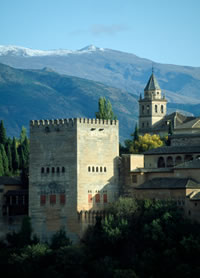 On the road south from Granada to the Mediterranean Sea, with the snow-capped Sierra Nevada sweeping up to the left, there's a pass where the rivers start running south. It's called the Puerto del Suspiro del Moro, The Pass of the Moor's Sigh.
On the road south from Granada to the Mediterranean Sea, with the snow-capped Sierra Nevada sweeping up to the left, there's a pass where the rivers start running south. It's called the Puerto del Suspiro del Moro, The Pass of the Moor's Sigh.
Here, in January 1492, the last Moorish ruler of Granada looked back for the final time towards the city. Boabdil is said to have wept, it was the end of his reign, and the end of 781 years of Muslim rule in Spain.
His mother, Ayxa is reputed to have scolded him, "You do well to weep as a woman over what you could not defend as a man".
The Christian Reconquista, which started in Asturias with Pelayo, was over.
PEOPLE
FEDERICO GARCÍA LORCA
As the peloton passed through the impossibly beautiful Andalucian mountains, heading towards Granada, it's easy to forget that this landscape contains some terrible secrets. It is said that thousands of Granadans are buried in unmarked graves in these hills, killed in fighting or executed by terror squads, in the civil war.
Among them is the dramatist and poet, Federico García Lorca.
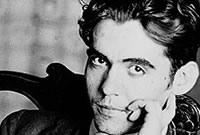 In 1936, García Lorca was at the peak his career, celebrated nationally and internationally. As an artist, an intellectual and a rumoured homosexual, he was a target for the reactionary Falangist rebels. He'd recently finished on of his great works, The House of Bernarda Alba.
In 1936, García Lorca was at the peak his career, celebrated nationally and internationally. As an artist, an intellectual and a rumoured homosexual, he was a target for the reactionary Falangist rebels. He'd recently finished on of his great works, The House of Bernarda Alba.
At the start of the war, Granada fell quickly to the rebels, and in the chaos of the early days, García Lorca was isolated, and quickly taken into custody. He was executed in August 1936, on a mournful mountainside near the village of Alfacar, a few miles north of Granada.
There is a statue in honour of Federico García Lorca in Madrid's Plaza de Santa Ana. It is reported that each day, the Left puts a red kerchief on the neck of the statue, and someone from the Right comes later to take it off.
SPAIN
PRINCE OF ASTURIAS AWARD
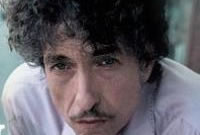 Bob Dylan has been awarded the 2007 Prince of Asturias Award for Arts.
Bob Dylan has been awarded the 2007 Prince of Asturias Award for Arts.
Other winners announced this year are US ex-Vice President Al Gore (International Cooperation) and Israeli writer, Amos Oz (Letters).
The Prince of Asturias Foundation aims to strengthen the links between the Principality of Asturias and its Prince and to contribute to upholding and promoting all those scientific, cultural and humanistic values that form the heritage of humanity.
H.R.H. Felipe de Borbón, Prince of Asturias is the Honorary President of the Foundation that bears His name since its creation in 1980.
The Foundation rewards scientific, technical, cultural, social and humanitarian work done by individuals, work teams and institutions, with priority given to the Spanish-American Community of nations.
Previous winners include Mikhail Gorbachev, Bill and Melinda Gates, Mario Vargas Llosa, Woody Allen and Nelson Mandela.
See PRINCE OF ASTURIAS FOUNDATION
PEOPLE
PRINCE OF ASTURIAS
 H.R.H. Felipe de Borbón is heir to the Spanish throne.
H.R.H. Felipe de Borbón is heir to the Spanish throne.
His father, Juan Carlos I, was proclaimed King on 22 November 1975, following the death of Franco. He received the title of Prince of Asturias in 1977, this title is held by the heir to the Spanish monarchy.
Prince Felipe married TV journalist, Letizia Ortiz Rocasolano, in 2004.
They have a two daughters, the Infantas Leonor and Sofía.
PEOPLE
CATHERINE OF ARAGON
Catherine, the first wife of King Henry VIII of England, was born in December 1485. Her parents, King Ferdinand of Aragon and Queen Isabella of Castille, were the most remarkable royal couple of the age.
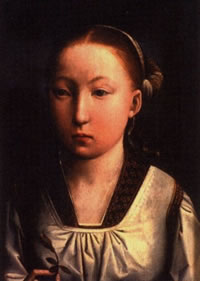 Aragon was rich and green, encompassing the foothills of the Pyrenees, the fertile valleys towards the Mediterranean, and the great trading city of Barcelona. It was an open, mercantile society.
Aragon was rich and green, encompassing the foothills of the Pyrenees, the fertile valleys towards the Mediterranean, and the great trading city of Barcelona. It was an open, mercantile society.
Catherine was sent to England in 1501 to marry Prince Henry's brother, Arthur, heir to the throne of England. He died suddenly a year later, perhaps because of a viral infection. Catherine also fell ill.
Ferdinand and Isabella were anxious not to lose the English alliance and instructed the Spanish ambassador to negotiate for a subsequent marriage to Prince Henry. Now King Henry VIII, he and Catherine were privately married in Greenwich in 1509.
A succession of pregnancies and miscarriages, and only one healthy daughter Mary, Henry decided to divorce Catherine, claiming their marriage wasn't valid.
They were divorced in 1533, and Catherine died three years later. It was widely believed that Anne Boleyn, Henry's second wife, had slowly poisoned Catherine to death.